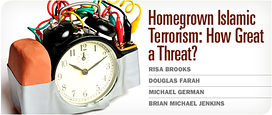It is unclear to me what Michael German is referring to in saying that the statute he references undermines the rest of my argument. I am not sure to which argument he is referring. Yes, it is illegal to give material support to a designated terrorist organization, in this case Hamas. This was what the Holy Land Foundation was convicted of. One can argue whether the designation, upheld across Republican and Democratic administrations, is warranted. I believe it is. But one cannot argue that material support, in this case money, (there were no free speech issues in the case) for a designated terrorist organization can be construed as over-broad or equated with teaching non-violent conflict resolution.
The reliable evidence presented in that case, from the internal documents of the Islamist groups themselves, is that CAIR, ISNA and other influential Muslim groups in the United States are directly founded by the Muslim Brotherhood groups in the United States, with the express purpose of advocating the end of democracy and the rule of law, as shown in this summary.
This was not denied or rebutted during the trial. Hamas, according to its own founding charter (Article 2) declares itself to be a branch of the Muslim Brotherhood, and defines the Muslim Brotherhood as “a universal organization which constitutes the largest Islamic movement in modern times. It is characterised by its deep understanding, accurate comprehension and its complete embrace of all Islamic concepts of all aspects of life, culture, creed, politics, economics, education, society, justice and judgement, the spreading of Islam, education, art, information, science of the occult and conversion to Islam.”
So, while the Muslim Brotherhood and its offspring in the United States are not designated terrorist organizations, the violent branch (Hamas) is. This to me demonstrates that the laws can be applied in a nuanced, narrow way to go after the actual supporters of terrorism rather than being used in an over broad sense, as German says, to infringe on civil liberties.
But my broader point was that these groups (with a total membership of a few thousand, making them a small minority within the Muslim community but the ones with the loudest political megaphone) embrace a theology that supports and justifies types of terrorism and anti-democratic forms of government. This is not illegal, nor has it been sanctioned. But it is dangerous and a potential pull factor in the recruitment of those who can be radicalized. The fact these groups have not been shut down is a tribute to the tolerance for free speech and what German calls “seemingly benign” associations. Several of the leaders of the Muslim Brotherhood legacy groups have been convicted of terrorist activities (Abdurahman Alamoudi, Mousa Abu Marzook, Sami al-Arian and others) but the organizations they founded and directed continue. This is not the Lusk Committee or anything resembling that. It is an attempt to explain who these groups are and how they contribute in the world of radicalization. The fact that the Muslim Brotherhood legacy groups are still in existence, I think, strengthens rather than weakens my argument.

